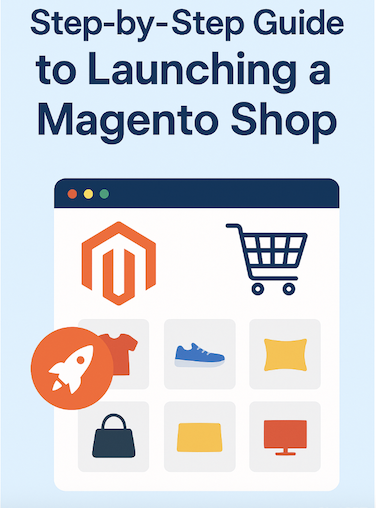Alright, so you wanna launch a Magento online shop and not just flail around in the ecommerce void?
Sweet, let’s get into it—with all the gritty bits, not just the “step one, do this” boilerplate.

Step 1: Define Your Business Vision
Don’t just start throwing products online because everyone and their dog has a store now. Pause. Seriously—think.
What are you even selling?
Who’s your crowd?
Hot yoga moms? Tech nerds?
Wandering gnomes?
And, like, why on earth should anyone care? Nail the vibe, lock down a catchy store name, whip up a sharp logo if you want people to remember you in two seconds.
If you can’t explain what makes you different without sounding like a robot, maybe rethink your angle.
Step 2: Choose the Right Magento Version
Okay, don’t let the versions freak you out:
- Magento Open Source: Free. Customizable. Good for folks not rolling in VC money.
- Adobe Commerce: Costs $$$, but you basically get the equivalent of a bouncer and a VIP section for your store.
Be real about your budget and ambitions. Chasing every bell and whistle might just make you miserable.
Step 3: Get Hosting and a Domain
Magento is a beast—don’t cheap out here. If your site crawls, people will bounce faster than you can say “cart abandonment.” SSDs, enough RAM to keep things zippy, and all that compatibility jazz with PHP and MySQL.
Oh, and pick a domain that doesn’t need to come with instructions. Secure it with SSL right off the bat. The padlock symbol? Customers want that, period.
Step 4: Install Magento
You’ve got two ways:
Either geek out and use Composer (it’s not as scary as it sounds) or hit that sweet one-click installer if your host is cool.
After it’s up, tweak the basics—your locale, language, currency, taxes.
Trust me, you don’t want angry European customers over surprise VAT drama.
Step 5: Pick and Customise Your Theme
First impressions are everything. Grab a theme that’s responsive and don’t get suckered into sliders and other clutter.
Make it yours—tweak the fonts, colors, layout. Simple navigation is key; people like shopping, not playing detective.
Step 6: Install Extensions and Tools
Out of the box, Magento’s solid, but you want more.
Get some SEO tools, slicker search, better checkout, whatever floats your boat—or makes it easier for people to buy more stuff.
Amasty’s cool if you want options that don’t suck.
Just don’t go wild and break your site with too many random add-ons.
Step 7: Add Products and Content
Products: good pics, punchy titles, clear descriptions—bonus points if it doesn’t sound like you copied it from a manufacturer. Set your pricing, keep tabs on stock.
Organize your stuff. Nobody wants to wade through chaos.
Put up a decent About page, FAQ, privacy and returns info, so people trust you and don’t feel like they’re about to get scammed.
Step 8: Set Up Payments and Shipping
Get those payment gateways (PayPal, Stripe, cards, whatever your people actually use). Offer options. Make checkout less painful than a root canal.
Sort out your shipping. Be upfront—nobody likes mystery costs at checkout.
Free shipping over a certain amount is the oldest trick in the book, but hey, it works. Tell people exactly when to expect their package or brace for angry emails.
Step 9: Optimise for SEO and Performance
You want Google juice, right? Tweak your URLs to be readable, pack product pages with real keywords, submit your sitemap, shrink your images. Caching? Do it. And if your site isn’t solid on mobile, you’re basically invisible.
Step 10: Test Your Store
Pretend to be your own customer—buy something, see what emails pop in. Try it on grandma’s iPad, whatever browser you can get your hands on.
Find every broken thing before your actual customers do (because they will, and they’ll tell you loudly).
Step 11: Launch and Promote
Ready? Throw a soft launch for friends or some loyal guinea pigs. Gather all the brutal feedback, patch stuff fast.
Now hype it up—get active on socials, fire off emails, toss out discounts, run giveaways, bribe an influencer (okay, maybe not bribe, but you know). Those first few weeks? That’s when you set the tone.
Step 12: Maintain and Improve
Look, launching your store? That’s just the first lap—not the finish line. If you wanna keep your shop buzzing, get in the habit of:
- Actually updating Magento and your extensions (don’t snooze on those notifications).
- Checking your analytics—seriously, those numbers aren’t just for show.
- Adding new products and shaking up your content every so often.
- Listening to your customers; their feedback is gold, even when it stings a little.
- Keeping an eye on SEO because, let’s be real, Google’s always changing the rules.
If you want your store to last, you gotta keep tinkering.
Conclusion
Starting a Magento online store might sound like a big, hairy monster, but honestly? Break it into pieces, use the right tools, and suddenly it’s way less scary.
The cool thing about Magento is how much wiggle room you get. You can start tiny or go full Amazon-wannabe if you play your cards right. The trick? Do some planning, keep up with the updates, and don’t sleep on adding new stuff—it’s what keeps people coming back.
Seriously. Extensions will make your life about ten times easier. If you want extra bells and whistles without pulling your hair out, check out Amasty’s extensions—they’re solid. Build a strong base, put in the work, and your Magento store can turn into something big, not just a side hustle. Keep going. You got this.


